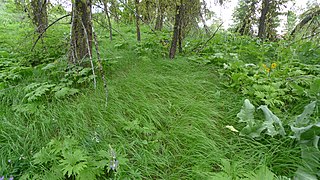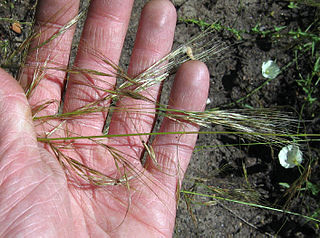
Filipendula ulmaria, commonly known as meadowsweet or mead wort, is a perennial herbaceous plant in the family Rosaceae that grows in damp meadows. It is native throughout most of Europe and Western Asia. It has been introduced and naturalised in North America.

Timothy is an abundant perennial grass native to most of Europe except for the Mediterranean region. It is also known as timothy-grass, meadow cat's-tail or common cat's tail. It is a member of the genus Phleum, consisting of about 15 species of annual and perennial grasses.

Arrhenatherum, commonly called oatgrass or button-grass, is a genus of Eurasian and North African plants in the grass family.

Elymus repens, commonly known as couch grass, is a very common perennial species of grass native to most of Europe, Asia, the Arctic biome, and northwest Africa. It has been brought into other mild northern climates for forage or erosion control, but is often considered a weed.

Molinia caerulea, known by the common name purple moor-grass, is a species of grass that is native to Europe, west Asia, and north Africa. It grows in locations from the lowlands up to 2,300 m (7,546 ft) in the Alps. Like most grasses, it grows best in acid soils, ideally pH values of between 3.5 and 5, however, it can continue to live under more extreme conditions, sometimes to as low as 2. It is common on moist heathland, bogs and moorland throughout Britain and Ireland. Introduced populations exist in northeastern and northwestern North America.
The mesotrophic grassland communities in the British National Vegetation Classification system were described in Volume 3 of British Plant Communities, first published in 1992, along with the calcicolous grassland communities and the calcifugous grasslands and montane communities.

Dactylis glomerata is a species of flowering plant in the grass family Poaceae, commonly known as cock's-foot, orchard grass, or cat grass (due to its popularity for use with domestic cats). It is a cool-season perennial C3 bunchgrass native throughout most of Europe, temperate Asia, and northern Africa.
British NVC community MG1, Arrhenatherum elatius grassland, is one of the mesotrophic grassland communities in the British National Vegetation Classification system. This type of plant community was named in 1919 as Arrhenatheretum elatiorisBr.-Bl.. It is a very widespread community throughout the British lowlands of England, Wales and southern and eastern Scotland.
British NVC community MG2 is one of the mesotrophic grassland communities in the British National Vegetation Classification system.

Bromus hordeaceus, the soft brome, is an annual or biennial species of grass in the grass family (Poaceae). It is also known in North America as bull grass, soft cheat, and soft chess.

Bromus diandrus is a species of grass known by the common names great brome and "ripgut brome".

Cercopis vulnerata is a species of froghopper in the family Cercopidae.

Alopecurus saccatus is a species of grass known by the common name Pacific foxtail, or Pacific meadow foxtail.

Calamagrostis rubescens is a species of grass known by the common name pinegrass.
Witton-le-Wear (SSSI) is a Site of Special Scientific Interest located in the valley of the River Wear, immediately east of the village of Witton-le-Wear in County Durham, England.

Festuca thurberi is a species of grass known by the common name Thurber's fescue. It is native to a section of the western United States encompassing New Mexico, Utah, Colorado, and Wyoming. It probably also occurs in parts of Arizona.

Eriocoma lemmonii is a species of grass known by the common name Lemmon's needlegrass. It is native to western North America, where its distribution extends from British Columbia to southern California.

Muhlenbergia lindheimeri is a species of bunch grass, 3-6' H, known by the common names big muhly, blue muhly, and Lindheimer's muhly. It is native to North America, where it can be found in northern Mexico and up to the Edwards Plateau region of Texas. It is also grown as an ornamental grass. as it is useful as a green screen, erosion control, water retention and nest material for many species of birds

Nassella lepida is a species of grass known by the common names foothill needlegrass, foothills nassella, foothill stipa, small-flowered stipa, small-flowered needlegrass, and smallflower tussockgrass.
Burnfoot River Shingle and Wydon Nabb is the name given to a Site of Special Scientific Interest (SSSI) in Northumberland, North East England. Burnfoot River Shingle is a calaminarian grassland on the River South Tyne where the local flora is influenced by high levels of naturally occurring heavy metals. Wydon Nabb is an escarpment displaying the Haltwhistle Dyke, a magmatic intrusion of igneous dolerite set amidst sedimentary sandstone and shale.




















